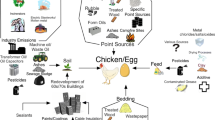Abstract
Dioxin and PCB monitoring programs for food and feeding stuff in most countries of the world, including many European Countries are currently inadequate. Better control of food production lines and food processing procedures is needed to minimize entry of dioxin to the food chain and will help to avoid dioxin contamination accidents. This would also improve the ability to trace back a possible contamination to its source. European guidelines for monitoring programs should be established to ensure comparable and meaningful results. These guidelines should define the minimum requirements for the design of monitoring programs, analytical methods, and quality assurance.
Though data from Northern Europe shows that the general population exposure to dioxin and PCB has decreased during the last ten years these compounds continue to be a risk of accidental contamination of the food chain. The most prominent recent example is the Belgian dioxin contamination of feeding stuff in 1999. The Belgian dioxin contamination was not detected due to dioxin monitoring programs but by their direct biological effects seen in animals. Four other cases of dioxin contamination have been detected in Europe since 1997 due to local monitoring programs. One of them (citrus pulp pellets 1998) was in a much larger scale than the Belgian dioxin contamination.
The general population’s exposure to dioxins and PCBs is still in the same range (1–4 pg WHO-TEQ/kg body weight and day) as the recently revised WHO tolerable daily intake (TDI). There is concern that short-term high level exposure to dioxins, furans, and PCB may cause biological effects on the human fetal development and further research is required.
Further actions to control sources building on considerable advances already made in many countries may need to be supplemented by measures to prevent direct contamination of feeding stuff or food to reduce general population exposure further.
Similar content being viewed by others
Author information
Authors and Affiliations
Corresponding author
Rights and permissions
About this article
Cite this article
Büchert, A., Cederberg, T., Dyke, P. et al. ESF Workshop. Environ Sci & Pollut Res 8, 84–88 (2001). https://doi.org/10.1007/BF02987298
Issue Date:
DOI: https://doi.org/10.1007/BF02987298




